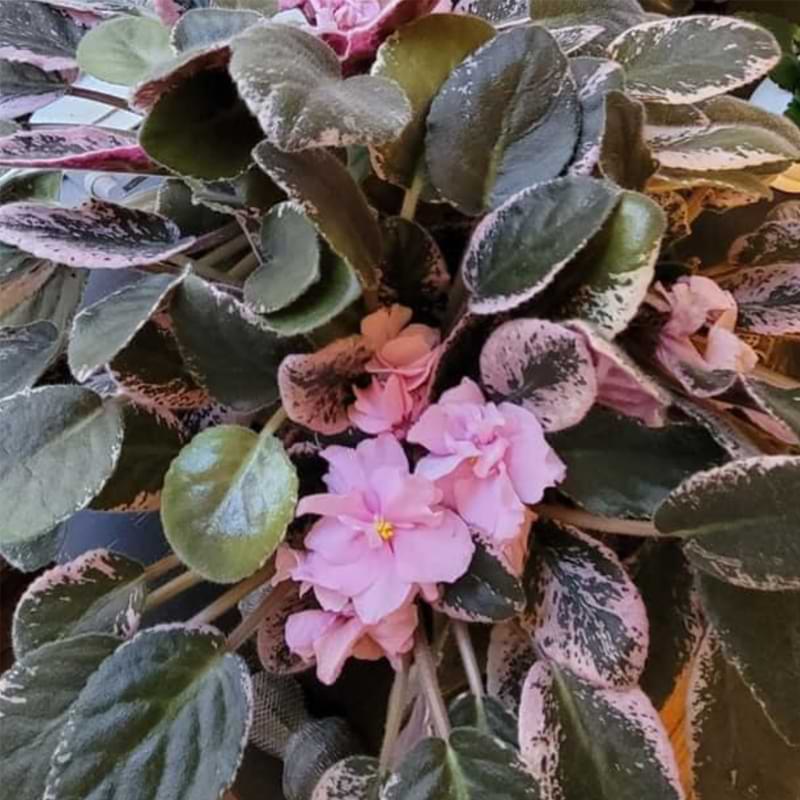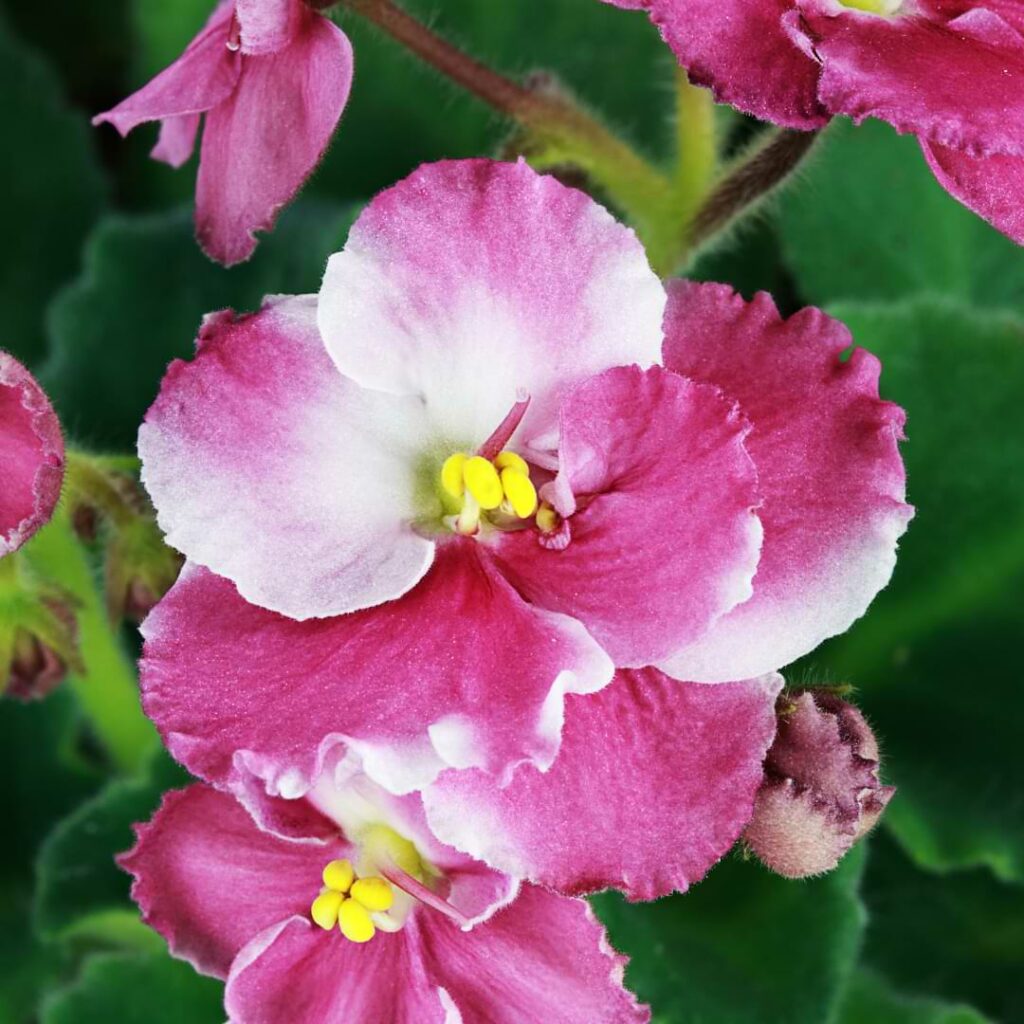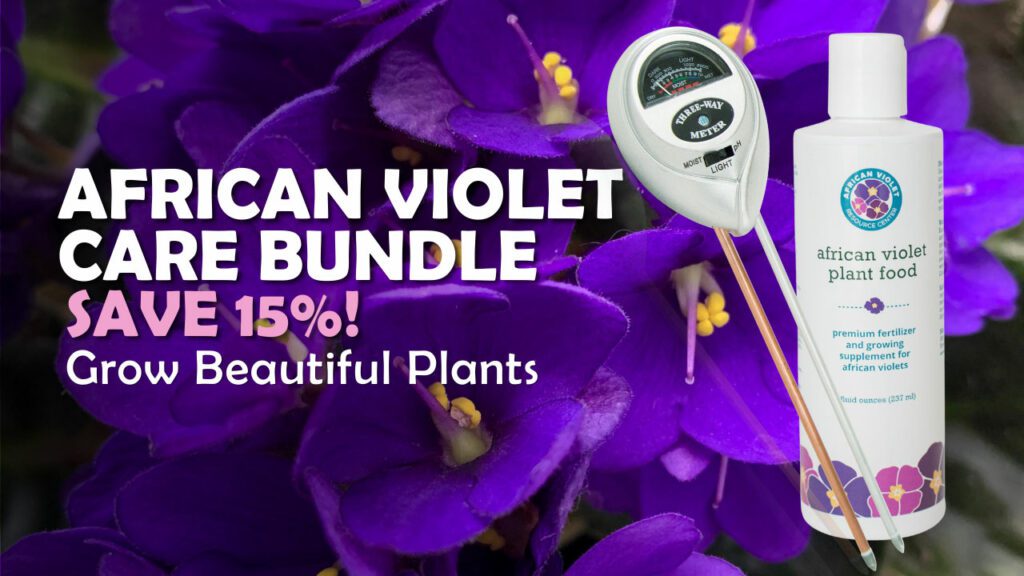The African violet (Saintpaulia) is a genus of 6–20 species of herbaceous perennial flowering plants in the family Gesneriaceae, native to Tanzania and adjacent southeastern Kenya in eastern tropical Africa. They are commonly known as Saintpaulias.
The flowers of African violets (Saintpaulia) have a double set of petals, with the innermost row of petals shaped into a crown. They come in many colors, including blue, red, purple, pink, white and bi-color. The flowers have five stamens fused at the base and a pistil with a three-lobed stigma.
Variegated African violets are some of the most popular African violets because of the added beauty the leaf variegation offers. There are many types of variegated African violets, so read on to learn more about them!
Variegated African Violets
Each variegated African violet comes with its own unique pattern and colors. There are some subtle differences between varieties when it comes to their size and colors.
Height & Spread
For the most part, variegated African violets are going to be between 6 inches in both height and spread up to 24 inches in height and spread. Some of the most popular varieties include:
-Lyon’s Private Dancer: This variegated African violet can grow to between 6-12 inches in both height and spread.
-Biscayne Trail: The beautiful trailing of this plant can reach an 8 inch spread, and it only grows to be 6 inches in height.
As you can see, height and spread for variegated African violets varies quite a bit.
Seasonality & Lifespan
African violets are typically evergreen plants, meaning they keep their leaves year-round. However, some varieties may lose their leaves during winter dormancy. The lifespan of an African violet varies depending on the species and cultivar, but most will live for several years with proper care. There have even been some variegated African violets to live upwards of 25 years!
Color of Foliage and Blooms
The color of the foliage and blooms on an African violet can vary depending on the variety. The most common foliage color is green, and the most common bloom colors are purple, white, and pink.
There are also varieties with blue or yellow blooms. The color of the foliage and blooms can also change depending on the time of year and the amount of sunlight exposure.
6 Types of Variegated African Violets
There are many different types of variegated African violets, each with their own unique pattern and coloration. Some of the most popular varieties include:
-Red Lion: This variety has deep green leaves with wide red margins. The flowers are typically a deep purple color.
-Royalty: This variety is characterized by its deep green leaves with wide white margins. The flowers are usually a light purple or lavender color.
-Serendipity: This variety features light green leaves with narrow white margins. The flowers are typically a pale pink or white color.
-Romance: A beautiful bright pink flower accents the variegated leaves of this plant, and the variegation on the leaves is pink too!
-Dwarf Variegated African Violet: As the name suggests, this variety is much smaller than other varieties of African violets. The leaves are variegated with shades of green, white, and pink, and the flowers are typically pink or purple.
-Miniature Variegated African Violet: This variety is even smaller than the dwarf variety, and has very delicate leaves that are variegated with shades of green, white, and pink. The flowers are typically pink or purple.
Getting More Variegation in African violets
There are a few things you can do to encourage more variegation in your African violets. First, make sure you are providing enough light. Variegated leaves need bright, indirect light to maintain their coloration. If your plant is not getting enough light, the leaves will revert to all green.
Second, keep an eye on your watering schedule. Too much or too little water can cause the variegation to fade or disappear altogether. African violets prefer to be kept evenly moist, so water when the top inch of soil feels dry.
Lastly, don’t forget to fertilize! A well-fed plant is a happy plant, and a happy plant is more likely to produce variegated leaves. Use our African Violet Plant Food formulated for African violets and apply it according to the package directions.

Variegated African Violets Care Guide
No matter which type of variegated African violet you choose, they all require similar care in order to thrive. Be sure to provide them with bright, indirect light and keep the soil moist but not soggy. With a little love and attention, your variegated African violet will bloom beautifully for years to come!
Light
First and foremost, these plants require bright, indirect light in order to maintain their vibrant colors. If they don’t receive enough light, the leaves will begin to revert back to their original green color.
How many hours of sunlight do African violets need?
African violets are typically thought of as low-light plants, but they actually prefer bright, indirect light. They’ll do fine in a north- or east-facing window, but if you want them to bloom their best, give them some supplemental light from a grow light or fluorescent light fixture. As a general rule, they should get about 14 hours of light per day.
Temperature & Humidity
As far as the temperature and humidity for your African Violet, there are a few things to keep in mind. African Violets prefer temperatures between 65-75 degrees Fahrenheit. They also like high humidity, so you may need to invest in a humidifier if you live in a dry climate. You can also increase the humidity around your plant by placing it on a pebble tray or grouping it with other plants.
Watering
Watering African violets is a little different from other types of houseplants. The biggest difference is that you never want to let the leaves of your plant get wet. Water should only be applied to the soil, not the leaves. This can be accomplished by using a watering can with a long spout, or by using a self-watering system.
If you have a self-watering system, fill the reservoir and check it regularly to make sure it doesn’t run dry. African violets need consistent moisture in order to thrive, so keep an eye on your plants and adjust your watering schedule accordingly.
Fertilizing
Fertilizing is an important part of caring for your variegated African violet. It is best to fertilize your variegated African violet once every two weeks during the growing season (spring and summer). During the winter months, you can reduce the frequency to once a month.
The best way to fertilize your African violet is by using a plant food that you can feed to your plant every time you water it. A specially-formulated plant food like this will ensure that your African violet is getting the perfect amount of nutrients it needs to thrive.
Flowering
In order to get your African violet to flower all year, you’ll need to ensure that it gets 14 hours of light every day. Using a grow light will ensure that you continue to see those beautiful flowers well into winter time!
Deadheading
Dead-heading is the process of removing spent flowers from a plant. In most cases, dead-heading will encourage the plant to produce more flowers. African violets are no exception. Dead-heading is especially important for variegated varieties, as these plants tend to produce fewer flowers than their green-leafed cousins.
To deadhead an African violet, simply snap off the flower stem at the base of the plant. You can also cut back the stem to just above a leaf node (the point where a leaf joins the stem). Be sure to use sharp, clean pruning shears or scissors when cutting, as this will help prevent disease.
Pot Size & Repotting
As your African Violet grows, you will need to repot it into a larger pot. But how do you know when it’s time to repot? And what size pot should you use?
Here are some guidelines for pot size and repotting:
– When your African Violet is first starting out, it will do best in a small pot (4 inches or so).
– As it grows, you can gradually move it up to a medium pot (6-8 inches).
– Once it reaches its full size, you can put it in a large pot (10 inches or more).
– You’ll know it’s time to repot when the roots start coming out of the drainage holes in the bottom of the pot.
– When you do repot your plant, be sure to use fresh potting mix and a clean pot that is only 1-2 inches larger than the one it is currently in.
Propagating Variegated African Violets
There are a few different ways that you can propagate variegated African violets. One way is to take stem cuttings from a healthy plant. To do this, cut a 4-6-inch piece of stem from the mother plant, remove the bottom leaves, and dip the cut end into rooting hormone. Stick the cutting into moist potting soil and keep the soil moist but not soggy.
Another way to propagate variegated African violets is by leaf cuttings. For this method, you will need a sharp knife or scissors. Cut a leaf from the mother plant, making sure to include a bit of the stem. Dip the cut end into rooting hormone and stick it into moist potting soil. Keep the soil moist but not soggy, and in 4-6 weeks you should see new growth!
Pests and diseases
Pests and diseases are common problems with African violets. Some of the most common pests include aphids, mealybugs, and whiteflies. These pests can be controlled with regular applications of insecticidal soap or horticultural oil. The most common way to deal with pests in houseplants is with high-quality neem oil.
Diseases that commonly affect African violets include gray mold, root rot, and virus diseases. These diseases can be controlled with the use of fungicides, but are easier to prevent than they are to treat. Follow the right watering schedule for your plant and keep it well away from any other plant that has contracted a disease.
FAQ Variegated African Violets
What is the most rare variegated African violet?
The most rare variegated African violet is the albino variety. This type of plant has white or pale leaves with no coloration.
Do variegated African violets need more light?
The answer to this question depends on the specific type of variegated African violet you have. Some types are more tolerant of low light conditions than others. If you are not sure what type of plant you have, it is best to ask your local nursery or gardening center for advice.
That being said, generally speaking, variegated African violets do need more light than their non-variegated counterparts. They will often produce fewer flowers in lower light conditions, and the leaves may become etiolated (stretched out and thin). If you want your plant to thrive, it is best to give it as much bright, indirect sunlight as possible.
Variegated African Violet Growing Final Thoughts
It’s easy to see why the variegated African violet is one of the most popular houseplants. They are relatively easy to care for and come in a wide range of colors and patterns. There are many types of variegated African violets, and there is sure to be one that would be perfect for your home! They don’t require too much care, and they can live for a very long time, so grab yourself one of the beautiful varieties of variegated African violets to enjoy in your home!
Join the African Violet Club!
Whether you’re just starting out or are a seasoned grower, African Violet Resource Center has everything you need to help your plant grow vibrant and strong. Explore our other articles, visit our online shop, and connect with other houseplant lovers in our Facebook group to learn everything you need to know about this rewarding hobby!
More Great African Violet Resources
7 Reasons You Need an African Violet Houseplant NOW!
Bottoms Up! The Best African Violet Watering Methods for a Happy Houseplant
Making Sense of African Violet Potting Mix (And How to Make it Too!)







